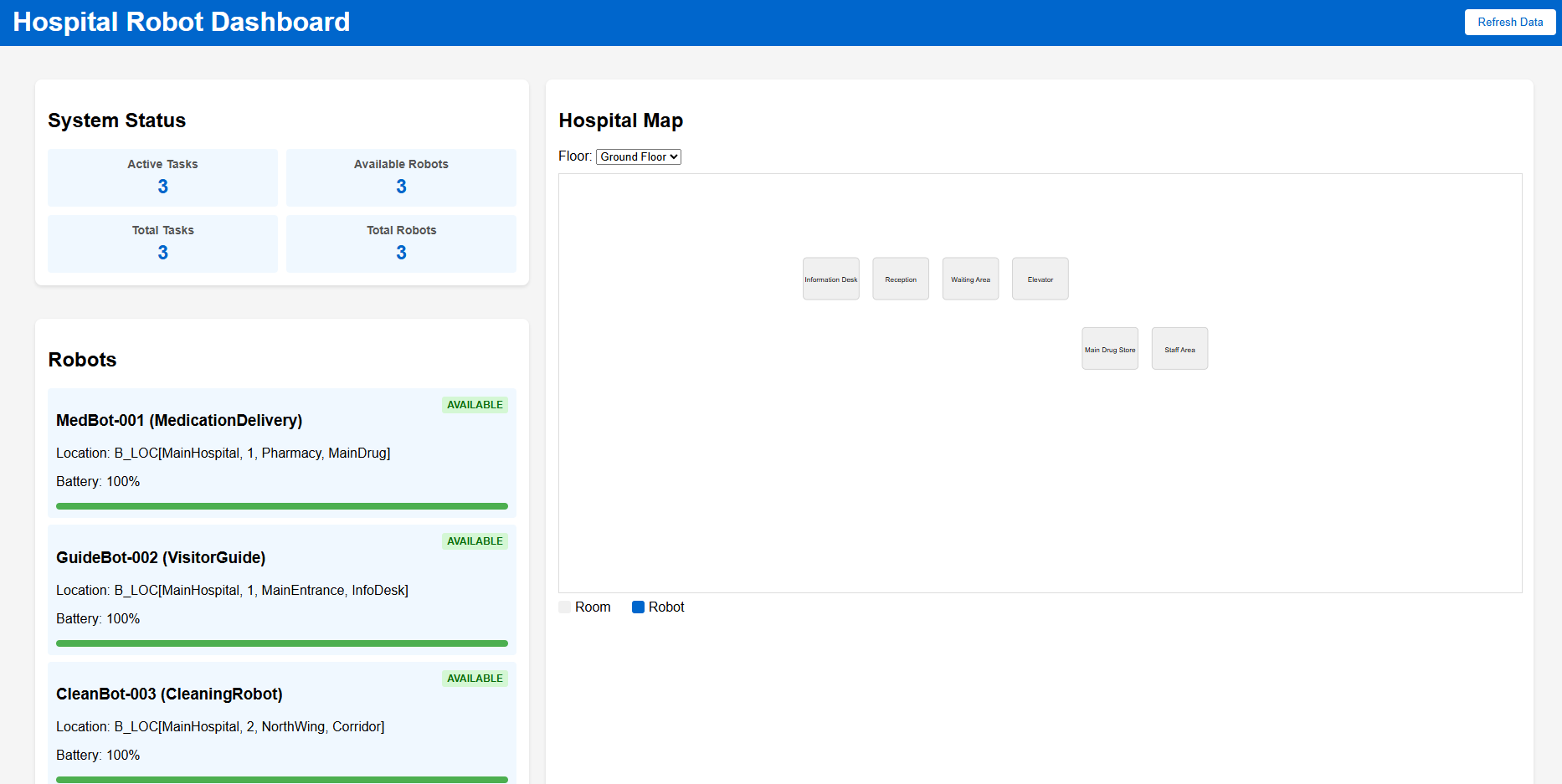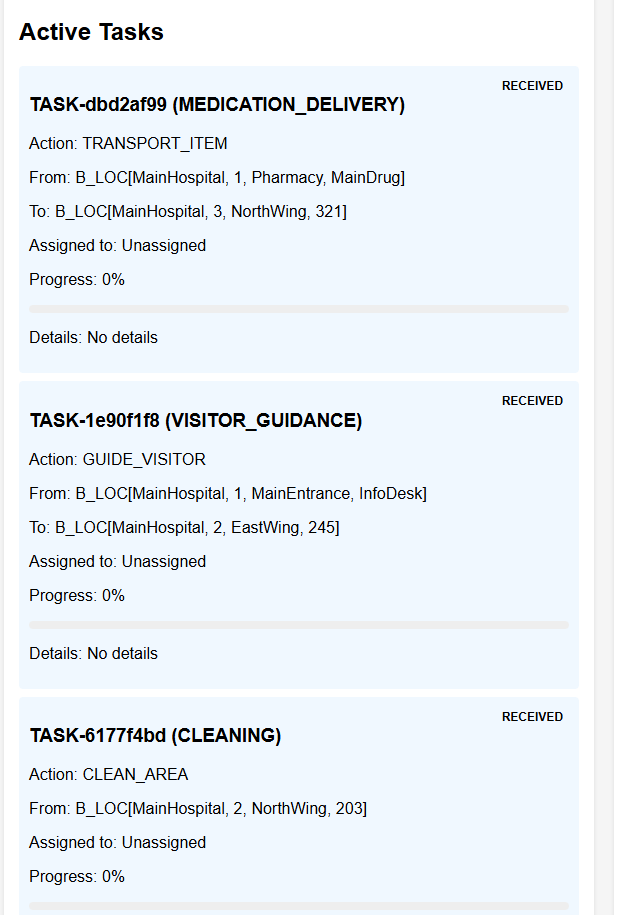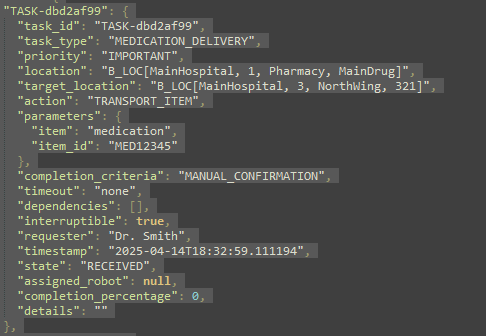Hospital Robot System: Aether in Healthcare Automation
The Hospital Robot System demonstrates how the Aether symbolic framework enables efficient, reliable, and flexible automation in critical healthcare environments. This demonstration showcases specialized robots coordinating through Aether's symbolic language to perform essential hospital tasks while maintaining consistent identity across system components.
System Overview

The system features multiple specialized robots, each with defined capabilities and roles within the hospital environment:
- InfoBot-A1: Information and emergency assistance robot positioned at elevator lobbies
- TransBot-P1: Patient transportation robot stationed at entrances
- MedBot: Medication delivery robot for secure transportation of prescribed medications
Aether Integration: Robot Identity
Each robot maintains its identity through Aether's symbolic representation. For example, the InfoBot's core identity is represented as ROBOT[ASSISTANCE, INFO_BOT, EMERGENCY_CAPABLE], creating a persistent identity structure regardless of which system component is handling the robot's data.
Task Management & Coordination

The central coordinator manages task assignment, scheduling, and conflict resolution through a symbolic task representation system.
Aether Integration: Task Representation
Tasks are defined using Aether notation such as TASK[MEDICATION_DELIVERY, PRIORITY:URGENT] with location expressed as B_LOC[MainHospital, 3, NorthWing, 321]. This structured representation ensures tasks maintain their semantic meaning across all system components from dashboard to robot agents.

The system converts between human-readable task descriptions and structured JSON for machine processing, while maintaining the semantic integrity defined by Aether's symbolic framework.
Key Aether Applications in Hospital Automation
Aether provides a structured way to represent hospital locations: B_LOC[building, floor, wing, room], enabling precise navigation instructions and location awareness.
Tasks are classified using standardized priority notation: PRIORITY[ROUTINE, STANDARD, IMPORTANT, URGENT, EMERGENCY], ensuring consistent handling of critical vs. routine tasks.
Robots advertise capabilities using Aether notation: CAPABILITY[MEDICATION_TRANSPORT, NAVIGATION, PATIENT_GUIDANCE], enabling dynamic task matching.
Standardized status reports with STATUS[ROBOT_ID, LOCATION, BATTERY_LEVEL, CURRENT_TASK] provide consistent monitoring regardless of robot type.
Complex tasks are broken down using Aether's symbolic structure: TASK[MEDICATION_DELIVERY].SUBTASKS[RETRIEVE, TRANSPORT, DELIVER, CONFIRM]
Structured error reporting: ERROR[NAVIGATION_BLOCKED].CONTEXT[LOCATION, OBSTACLE_TYPE].ACTION[REROUTE]
Advantages of Aether in Hospital Automation
1. Vendor-Neutral Communication
In real hospital deployments, robots from different manufacturers must coordinate seamlessly. Aether provides a vendor-neutral symbolic language that bridges proprietary systems, enabling hospitals to mix robot types without compatibility issues.
2. Semantic Consistency
Hospital environments require absolute precision. Aether ensures that critical concepts like medication types, isolation protocols, or emergency procedures maintain consistent meaning regardless of which system component is processing them.
3. Human-Machine Communication Bridge
Healthcare staff need intuitive interfaces. Aether's symbolic structure translates between human-readable commands ("Take this medication to Dr. Smith in Room 302") and machine-actionable instructions without losing context or intent.
4. Auditability & Compliance
Healthcare automation demands accountability. Aether's structured representation creates inherently traceable operations, facilitating compliance with healthcare regulations and providing clear audit trails for all robot actions.
5. Extensibility
As hospital requirements evolve, Aether's extensible framework allows new capabilities, robot types, or tasks to be integrated without disrupting existing operations - enabling incremental deployment of automation.
Real-World Implementation Path
In a production hospital environment, Aether would be integrated at multiple layers:
- Interface Layer: Aether notation would be embedded in APIs between hospital information systems (EHR, PACS, etc.) and the robot coordination system
- Coordination Layer: The central scheduler would use Aether's symbolic structure for task representation, priority management, and conflict resolution
- Robot Agent Layer: Individual robots would translate vendor-specific commands to/from Aether notation
- User Interface Layer: Staff interfaces would display Aether-structured information in human-readable form
- Analytics Layer: Operational intelligence would be extracted from Aether-formatted logs for system optimization
This layered implementation ensures that Aether's benefits extend throughout the automation ecosystem while allowing for gradual adoption and integration with existing systems.
Conclusion
The Hospital Robot System demonstrates how Aether transforms healthcare automation from disconnected proprietary systems into a cohesive, interoperable ecosystem. By providing a symbolic language for representing locations, tasks, capabilities, and status, Aether enables reliable automation in environments where precision and consistency are paramount.
This demonstration shows only a fraction of Aether's potential in healthcare settings. Future extensions could include integration with electronic health records, automated medication dispensing, specimen transport, and even cognitive assistance for clinical decision-making - all unified through Aether's consistent symbolic framework.